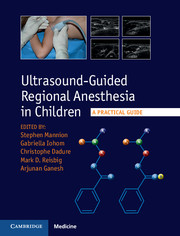Book contents
- Frontmatter
- Contents
- List of contributors
- 1 Introduction
- Section 1 Principles and practice
- 2 Performance of regional anesthesia in children
- 3 Pharmacology of local anesthetics in children
- 4 Management of complications of regional anesthesia
- 5 Basics of ultrasonography for regional anesthesia in children
- 6 Anatomy of the neuraxis, thoracic and abdominal walls, upper and lower limbs
- Section 2 Upper limb
- Section 3 Lower limb
- Section 4 Truncal blocks
- Section 5 Neuraxial blocks
- Section 6 Facial blocks
- Appendix: Muscle innervation, origin, insertion, and action
- Index
- References
6 - Anatomy of the neuraxis, thoracic and abdominal walls, upper and lower limbs
from Section 1 - Principles and practice
Published online by Cambridge University Press: 05 September 2015
- Frontmatter
- Contents
- List of contributors
- 1 Introduction
- Section 1 Principles and practice
- 2 Performance of regional anesthesia in children
- 3 Pharmacology of local anesthetics in children
- 4 Management of complications of regional anesthesia
- 5 Basics of ultrasonography for regional anesthesia in children
- 6 Anatomy of the neuraxis, thoracic and abdominal walls, upper and lower limbs
- Section 2 Upper limb
- Section 3 Lower limb
- Section 4 Truncal blocks
- Section 5 Neuraxial blocks
- Section 6 Facial blocks
- Appendix: Muscle innervation, origin, insertion, and action
- Index
- References
Summary
Introduction
Ultrasonography is a tool that allows us to visualize with increasing detail internal anatomy such as nerves, vessels, and organs. It can be tempting to use this technology to bypass traditional anatomy learning and to simply identify individual structures in a two dimensional image. Excellence in regional anesthesia requires intimate and detailed knowledge of the anatomy of the nerves, their neighboring structures, and, most importantly, the functional anatomy of the skin, muscles, or bones these nerves supply. This chapter provides that detail and the background knowledge to perform safe and successful regional anesthesia in children. The Appendix contains a list of tables where the innervation, origin, insertion, and action of each muscle are described – these tables are referenced in the text to their relevant anatomic section.
Neuraxis
The back provides a protective pathway through which the spinal cord passes and spinal nerves exit. The bony contribution is provided by the vertebrae. Ligaments provide supportive connections between the bony elements, and related muscles connect the vertebrae to each other and to adjacent structures, such as the ribs.
Vertebrae
There is a basic structure to all vertebrae with differences occurring depending on their position within the vertebral column. The five categories are:
• Cervical – small in size, foramen situated in transverse processes.
• Thoracic – have articulations for ribs.
• Lumbar – large-sized vertebral bodies. over-lapping articular processes.
• Sacral – five fused vertebrae, with four sacral foramina, and the sacral hiatus.
• Coccygeal – between three and five vertebrae, that may or may not be fused.
A typical vertebra has a vertebral body lying anteriorly to a vertebral arch, the largest vertebral bodies being found in the lumbar area. Each vertebra is separated from its neighbor by a fibro-cartilaginous intervertebral disc.
The vertebral arch is formed posterior to the vertebral body by the two pedicles providing the lateral walls, and the roof formed by the two laminae, joining at the midline. Together these structures surround the vertebral foramen, and the foramina of each vertebra are aligned to form a continuous canal from the magnum foramen in the skull to the lowest point on the sacrum at the sacral hiatus. Within this protective space are the spinal cord and associated membranes, blood vessels, supportive connective tissues, and the emerging spinal nerves.
- Type
- Chapter
- Information
- Ultrasound-Guided Regional Anesthesia in ChildrenA Practical Guide, pp. 40 - 62Publisher: Cambridge University PressPrint publication year: 2015



